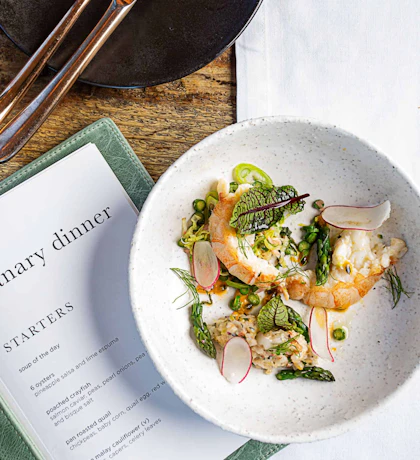Not ready to book just yet? Submit an enquiry and our team will be in touch within 24 hours.
A Royal Portfolio Recipe: Cape Malay Specialties
The Silo HotelAs many of our guests stay at home to combat the spread of Covid-19, we wanted to share some of our Executive Chefs’ favourite recipes for you to try at home.
The Dutch imported slaves into South Africa from numerous countries but for the most part from the Dutch East Indies (now Indonesia) among other South-East Asian countries. Cape Malay cuisine is a beautiful combination of Asian, European and African flavours. The Malay influence includes the marrying of sweet and savoury flavours. Dishes are aromatic and often incorporate fruit, meat, herbs and spices, notably ginger, cinnamon and turmeric.
The best place to experience Cape Malay cuisine is in Bo-Kaap (Above The Cape) District in Cape Town, an area with steep cobblestone streets and brightly-coloured houses where former Cape Malay slaves settled in the early 19th century. To explore the Cape Malay heritage further, read our Artist Spotlight on Thania Petersen.
Executive Chef Veronica Canha-Hibbert from The Silo Hotel shares a few signature Cape Malay recipes – Cape Malay Beef Curry, Bobotie and Rotis. A description of the characteristics of the spices and herbs used in Malay cooking has also been outlined below.
CAPE MALAY BEEF CURRY
This is a medium-strength curry, it takes a while to cook but is well worth the wait. Serves four.
Ingredients
1 1/2 t turmeric
1 1/2 t cumin, ground
1 1/2 t coriander, ground
2 bay leaves, whole
1/2 t cinnamon, ground
1 1/2 t chilli powder
3 onions, chopped
2 cloves garlic, finely chopped
1 1/2 t ginger, grated
1 green pepper, diced
700g beef, cubed into bite-size pieces, fat removed (stewing beef or goulash beef)
80 g dried apricots, chopped
2 t red wine vinegar
300ml beef stock
1/2 t salt
2 t oil
250ml water
Method
Heat the oil in a large pot over a medium-high heat. Add the turmeric, cumin, coriander and onion. Cook for 2 minutes, until the onion begins to soften. Add the beef and fry for a further 3 minutes, until the beef is browned. Next add the ginger, bay leaves and garlic and cook for a minute. Finally add the beef stock, water, green pepper, cinnamon, chili powder and salt. Stir to mix the flavours, cover and lower the heat. Simmer for 1 1/2 hours, stirring occasionally. To finish the dish, add the dried apricots, red wine vinegar and simmer for a further 20 minutes or until the beef is very tender. Served with brown rice (add a handful of lentils halfway through the cooking of the rice for a variation), sliced banana, and chutney.
ROTIS
A roti is unleavened bread & is served instead of rice, with chutney. A roti rolled around curry mince filling is known as a salomi – a traditional Malay fast food.
Ingredients
750 ml cake flour
100 ml self – raising flour
5 ml salt
45 ml cooking oil or soft butter
250 ml cold water
100 ml cake flour (reserve for rolling of roti)
90 g butter
50 ml melted butter mixed with 50 ml cooking oil
Method
Combine flours & salt in a bowl. Add oil or butter, rubbing it into flour to form a crumbly mixture. Add water & mix to a soft dough. Knead, adding more flour (if required) to make an even-textured, pliable dough. Cover & leave to rest for 30 minutes. Divide the dough into 8 -9 pieces. Roll each out on a lightly floured surface to a circle 20cm in diameter, dot with 15 ml of butter and sprinkle with flour. Roll & stretch into thick ropes of dough. Roll up both ends of the rope, one clockwise & the other anti-clockwise, and fold one half on top of the other. Cover & allow resting for an hour. Roll out on lightly floured surface to circles 20 cm in diameter. Heat a heavy-based frying pan & fry Rotis one at a time, turning occasionally & brushing with butter and oil mixture. Fry till golden. Remove from pan and pat between palms to fluff surface.
BOBOTIE
Serves six.
Ingredients
2 tablespoons vegetable oil
2 onions, peeled and chopped
1kg lean ground beef
1 thick slice of white bread
1 cup milk
1 tablespoon medium curry powder (or hot for the hale and brave)
1 1/2 tablespoons sugar
2 teaspoons salt
freshly grated pepper (about a half teaspoon)
3/4 teaspoon turmeric
1 1/2 tablespoons vinegar
1/2 cup seedless raisins
2 tablespoons chutney
2 bay leaves (or fresh lemon leaves if available)
2 medium eggs
Flaked Almonds (optional)
Method
Preheat oven to 180°C. Heat oil in a medium sauté pan. Stir in onions. Cook over medium heat until transparent. Add ground beef. Cook until lightly browned and crumbly. Soak bread in half the milk, squeeze out excess milk and mash with a fork – DON’T TOSS SQUEEZED OUT MILK! Pour it straight back into remaining milk. Set milk aside, and ad pulled-apart bread to the meat mixture. Add curry, sugar, salt, pepper, turmeric, vinegar, raisins, and chutney to the beef mixture. Spoon the mixture into a greased baking dish, and place bay leaves on top. Bake for 50-60 minutes in preheated 180°C oven. Beat egg with remaining milk and pour over mixture approximately 25 – 30 minutes before the end of baking time. Serve with steamed rice (traditionally yellow!) and extra chutney. Pure South African comfort food! Especially nice in winter, or cold with a salad in summer.
THE CHARACTERISTICS OF SPICES AND HERBS USED WITHIN CAPE MALAY CUISINE
All Spice: this sun-dried berry of the West Indian Pimento tree seems to combine the flavours of nutmeg, cinnamon and cloves, hence its name. It is used in the preparation of many masalas and is therefore a popular spice to flavour curries, soups and bredies. It can also be used in desserts cakes and biscuits.
Aniseed: the seeds of the Aniseed plant are used mainly in confectionery because of their warm, sweet liquorice flavour. Aniseed should be used sparingly, as the flavour can be overpowering. Star Aniseed is rarely used on their own but is ground and used in Breyani Masala and Garam Masala.
Barishap: also known as Fennel, Barishap is a strong- smelling yellow flowered plant, whose seeds look very much like Jeera but are fatter and less elongated. These aromatic seeds have a warm, slightly bitter, Aniseed flavour and are used in fish dishes and savoury dishes such as Chevro. Ground Barishap is often used in Breyani Masala and is ideal to chew after a spicy meal as it freshens the breath.
Bay Leaf: the bay leaf comes from the sweet bay or true laurel tree. It is aromatic with a sweet bitter taste and is used in the preparation of dishes such as pickled fish, sosaties and deningvleis.
Borrie: also called turmeric is a deep yellow ground spice obtained from the dried root of a plant related to ginger. It has a slightly bitter taste and care should be taken not to exceed the amount recommended in a recipe. Borrie is used mainly for flavouring curies, pickled fish and sosaties and for colouring yellow rice.
Cardamom: known as elachi in the Indian community, dried cardamom seeds are available in to varieties – green and white. It is best to buy cardamom in small quantities as they lose their pungent aroma and distinctive flavour after they have been ground.
Chilli: there are 30different varieties of chilli, some much sharper than the others. Unripe or green chillies are juicier, with more flavour, while ripe or red chillies are hotter. Pounded or liquidized chillies mixed with a little oil and salt can be stored in sealed containers in the refrigerator.
Chilli Powder: generally red in colour and made from dried red chillies, chilli powder imparts to food the distinctive bite which is characterized of Malay dishes.
Cinnamon is the spice obtained from the yellowish- brown bark of a tropical tree and has a rich, spicy aroma and a delicious, sweet flavour. In Malay cooking, stick cinnamon is added to curries, breyani, vegetables, puddings and desserts. Ground cinnamon is also used in melktert and other confectionery.
Cloves: are the dried, unopened flower buds of yet another tree indigenous to Indonesia. They have a pronounced aroma and strong, almost bitingly sharp, spicy taste. Cloves are used to flavour many savoury and sweet dishes. Ground cloves are stronger in flavour than whole ones, so use only a pinch, for the flavour can be overpowering.
Cumin: is a strong savoury spice, one of the most important in Malay cuisine. Like coriander, foundational in both Three- spice and warm masalas. Seeds often feature as pan spices
Curry Leaves: are available fresh or dried. Fresh curry leaves are used mainly for garnishing curry dishes while dried ones are used in the preparation of leaf masalas and for adding extra flavour to savoury dishes.
Curry Powder: a mixture of whole koljander, jeera, ginger, black peppercorns, chilli, and mustard seeds is at its best when all the spices are freshly ground.
Dhania: this is the name given to fresh coriander leaves which is used for both garnishing and flavouring curry dishes savouries such as Samoosas. Pounded dhania leaves are also an important for chutneys.
Garlic: a popular herb and a member of the onion family, garlic is often used fresh in combination with fresh root ginger. Garlic, if minced with a little oil and salt, will last well in the refrigerator.
Ginger: as with nearly all spices contains a volatile oil that gives it its distinctive flavour which is aromatic, biting and slightly sweet. Fresh ginger is indispensable when making curries and breyani and if mixed with garlic makes an excellent meat tenderizer. Ground ginger is used in flavouring koeksisters, konfyts, puddings and cakes.
Koljander: also known as coriander, this is a seed which tastes sweet and aromatic and should be roasted before it is ground in order to bring out its curry – like flavour. Koljander seeds crushed together with jeera are widely used in curries and other meat dishes.
Garam Masala: is a mixture of cinnamon, cloves, jeera, cardamom, black pepper, nutmeg, mace and koljander and lends a fragrant, rather than hot, quality to food. To learn how to make your own Garam Masala, click here.










